Using console as a multi-effector for guitars
This example shows how console may be used by a guitarist.
Assuming use under a live performance setting, a Roland FC-200 will be used as the foot controller.
The console project file for this example is available for download (see end of page).
Objective
To route effect plug-ins within console for use as a guitar effector for a guitar. A MIDI foot controller will also be set up to control the effects, so that console can be used for live performances.
Equipment
| PC | B5 laptop PC (Pentium M 1.6GHz, 1GB RAM) |
|---|---|
| Audio/MIDI interface | RME Hammerfall DSP Multiface (Cardbus) |
| Preamp | JoeMeek ThreeQ |
| Foot controller | Roland FC-200 |
Equipment setup
The physical connection of the equipment is shown below.

Software setup
Since console will be used as a multi-effector, the direct monitor on the audio interface should be disabled. With Multiface, this is done on the driver. Some audio interfaces may require you to change the setting on the device.
Audio interface setup
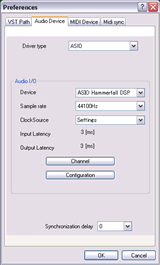
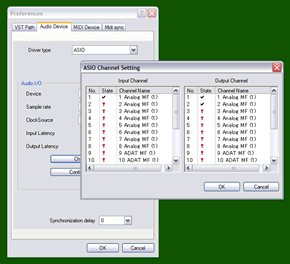
Select "ASIO" for the driver type. Disabling unused I/O ports will reduce the load on the system.
MIDI interface setup
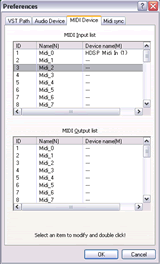
You do not need to setup the MIDI out for this project.
Sound check
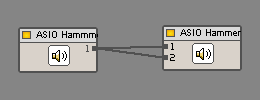 On
the console patch editor, load the modules for audio-in
and audio-out, and connect them directly.
On
the console patch editor, load the modules for audio-in
and audio-out, and connect them directly.
Click the power button (next to the play button) to start the audio engine. console's audio engine will not operate until you have clicked the power button.
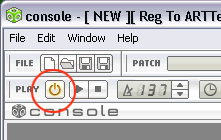
At this point, you should be able to get audio output by playing on
the guitar. If you do not get any sound, check your connections.
If you continue to get sound after disconnecting the two modules, or
if you hear some overlap in the sound, the direct monitoring function
may be ON. Check the settings for your device and/or driver.
Routing
After setup is complete, you can proceed to sound composition.
Making guitar sounds
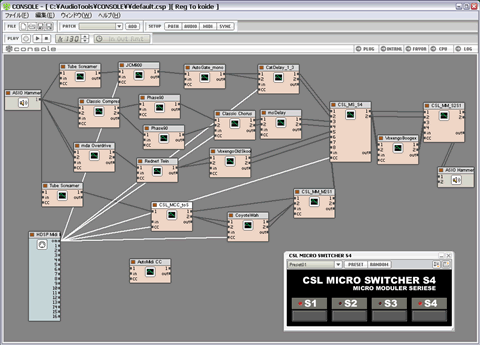
Here is an example for a typical set of guitar sounds. From the top line:
(1)Heavily distorted sound for solo and backings.
(2)Clean sound for arpeggios, etc.
(3)Wide-ranged, general-purpose sound covering from a clean, natural
sound to a crunchy distortion.
(4)Sound featuring pedal wah.
The sounds are grouped into 4 systems for clarity, and are switched by using CSL MICRO SWITCHER S4 (CSL_MS_S4) included with console.
There is a Voxengo Boogex plug-in inserted prior to the final output. This plug-in is used to add a cabinet impulse response. Adjust the cabinet impulse response using the mix balance on the CLS_MM_S2S1 mixer plug-in that follows.
Foot controller setup
FC-200 uses "control change mode" to switch buttons ON/OFF on the CSL MICRO SWITCHER.

The expression pedal is assigned to the parameter on each routing that you wish to control in real-time.
(1)Volume (JCM900)
(2)Dry/wet chorus (Classic Chorus)
(3)Overdrive control (mda Overdrive)
(4)Wah (CoyoteWah)
Pedals are also assigned to control the ON/OFF for (2)'s delay, and the ON/OFF of (4)'s wah. (By using AutoMidi CC instead of the pedal for (4), you can achieve an effect similar to touch-wah.)
The pedal assignment is illustrated below.
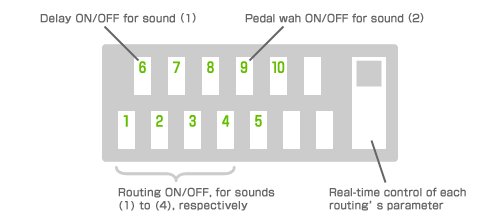
Application tips
When working in console, you do not necessarily need to follow the general rules for connecting effects. There is no risk of damaging your effectors (plug-ins) because of an irregular connection. (Note, however, that sudden loud noise may be damaging to your ears and/or speakers.)
You will not experience deterioration in sound even if you connect a multitude of effects. Enjoy the freedom of composing sounds "out-of-the-box".
Advanced tips
Using a single controller switch to control multiple plug-ins
You can send a single MIDI message to multiple plug-ins simultaneously.
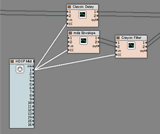
In this routing example, 3 plug-ins are controlled simultaneously with a single MIDI message.
Using MIDI plug-ins
There are various VST plug-ins that only support MIDI.
For example, MoCON 8 LFO available from https://drunk.smartelectronix.com/ allows
you to send LFO signals as MIDI to other plug-ins, enabling you to
modulate any effector parameter.
E.g.
- Auto-wah triggered by tempo
- Auto-pan
- Tempo-controlled mixing of effects
- Using parallel connections
Interesting results can be achieved by using multiple effects in parallel. Parallel effects are difficult to accomplish with hardware effectors, but are quite simple with console. And by using a pedal to adjust the mix balance, you can pull off tricks like gradually switching to a different sound.
Links
Tube Screamer, JCM900, Rendef Twin (GuitarSuite): https://www.simulanalog.org/
Coyote Wah: https://www.coyotes.bc.ca/
Voxengo Boogex, Voxengo OldSkoolVerb: https://www.voxengo.com/
mda Overdrive: https://www.mda-vst.com/
Classic Compressor, Classic Chorus: https://www.kjaerhusaudio.com/
Phase90: https://antti.smartelectronix.com/
CatDelay: https://www.geocities.jp/webmaster_of_sss/
(https://www.geocities.jp/webmaster_of_sss/vst/)
msDelay (MS tools): https://mdsp.smartelectronix.com/
Auto Midi CC: https://www.frettedsynth.com/
(*This plug-in was not actually used in the above examples)
[Project file for this example]
Download <console_for_guitarists.zip>
* You will need to reconfigure the device settings to match your environment.
* This document does not guarantee that the plug-ins introduced herein will be fully functional with console.



